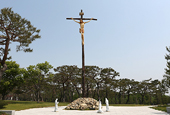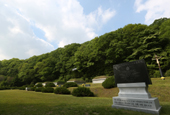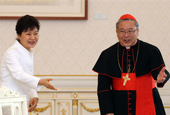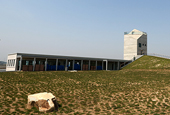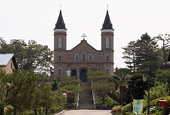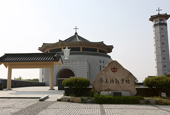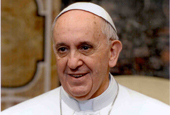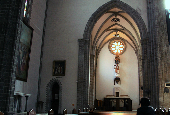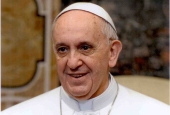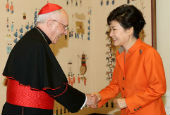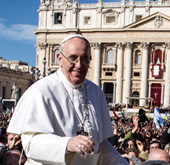The Yeosaul Holy Place in Yesan County, Chungcheongnam-do (South Chungcheong Province), is the birthplace of Lee Jonchang Louis de Gonzague (1757-1801), the "Apostle of Naepo." It was he who taught the Gospel to the families of St. Andrew Kim Dae-geon and Thomas Choi Yang-eop, the first two Korean Catholic priests. Yeosaul is a place where "Western learning" grew beyond the study of merely Western knowledge and began spreading as a religion, in this case as Catholicism. Catholicism continued to thrive here until the great persecution of 1866.
Yeosaul was a major transportation hub, where the small Sapgyeocheon and Muhancheon rivers met. The Sapgyocheon was so deep that ships were able to reach far inland and people took boats to Seoul from Yesan and Hongseong counties. The name Yeosaul is said to have originated from "Yeoseul," a creek with fast moving water. On a small hill at the Yeosaul Holy Place is a large stone signpost showing that this is the birthplace of Lee Jonchang. There is also a picturesque church on the opposite side.
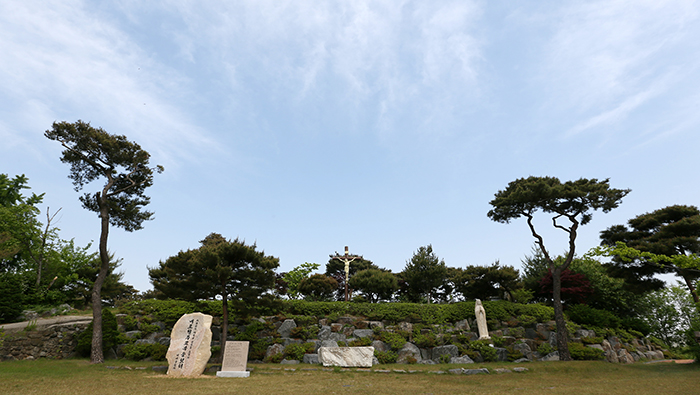
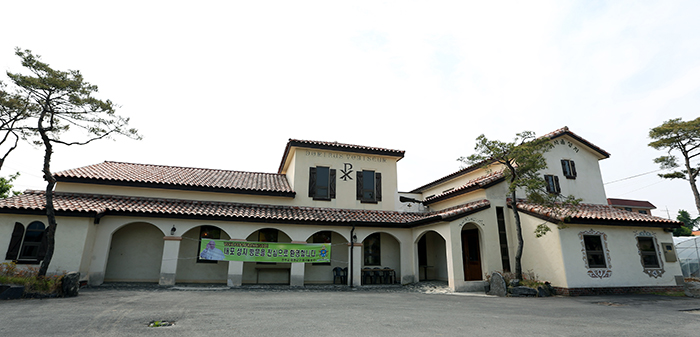
Lee, who was an in-law of the families of both St. Andrew Kim Dae-geon and Thomas Choi Yang-eop, played a key role in spreading Catholicism in the area. Born to a rich farming family, when he grew up and became a young man, Lee went to Seoul with a yearning for knowledge. There, he met the great scholar Francesco Saverio Kwon Il-sin and became his pupil. In 1785, Lee was baptized and converted to Catholicism.
Lee returned to his hometown to spread the Gospel and convinced his family and relatives to join the faith, as he was responsible for spreading the teachings of Catholicism across the Chungcheong-do region. Soon, the village became a religious community with 300 followers. Later, Lee taught the Gospel to the farmers and to the lower classes in the Naepo area, now including the towns of Yesan, Asan, Dangjin, Haemi, Deoksan, Hongseong and Seosan. It was then that Naepo became a starting point for Catholicism in Korea.
The fifth Bishop of Joseon, Marie Nicolas Antoine Daveluy (1818-1866), wrote that most Catholics in the 1850s were descendants of those who Lee helped to join the faith. Eventually, Lee became an apostate, as he gave in to severe torture and beatings during the great persecution of 1791, but he deeply repented his apostasy and tried to continue teaching the Gospel. However, he was arrested again in 1795 and lived in prison until his death in Gongju in 1801.
Hongseong Country, Chungcheongnam-do, formerly known as Hongju, is also one of the places where Lee Jonchang taught Catholicism. According to records, there were 212 martyrs executed here, but if nameless martyrs are included, the number would grow to over 1,000.
Commoners and the lower classes of Naepo willingly embraced Catholicism as they were moved by its religious doctrine that stresses equality before God. Hwang Il-gwang, a member of the lower classes, was one of the people who were strongly impressed when he was treated equally, without discrimination, by the aristocrats. According to records, he said, "People treat me so gently, despite my status. There must be a heaven in this world and another life in the afterlife."
In Hongseong County today, there is a well-organized pilgrimage route, called the Naepo Culture Forest Way. The route leads to the Hongju Martyrdom Holy Grounds, including the burial grounds and a place where many martyrs were executed. In 2012, a Joseon prison was restored at the Hongju fortress. Many followers kept their faith while in prison, despite torture and executions. The pilgrimage also heads to the Wolgyecheon Stream. There are signs showing that there were executions and burial grounds near the stream. Many martyrs, including Hwang Il-gwang, were beheaded on these execution grounds.
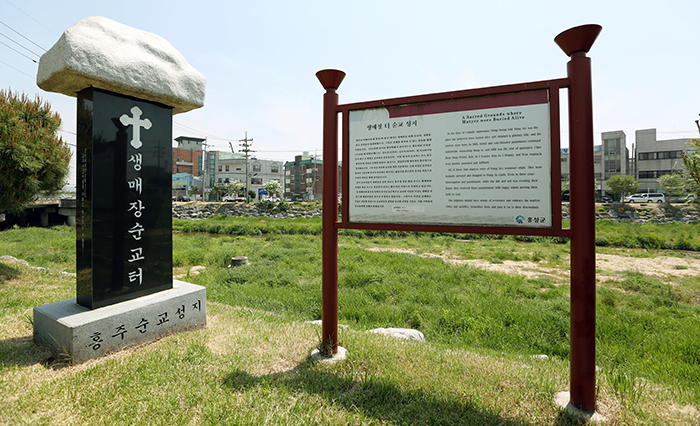
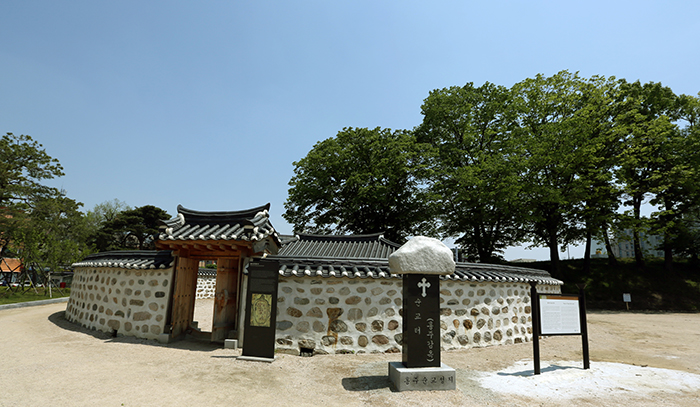
"Scholars who lost power during the reign of King Sukjong (r. 1674-1720) came down to the Naepo area, which was close to Seoul, and studied Western learning, which led to the growth of Catholicism in Naepo," said Father Youn In-gyu Laurentio, the current rector of the Yeosaul Holy Place. "This was an early Catholic community that continued to thrive until the great persecution of 1866. This is a historic place."
"The people of Naepo had hopes for a new era, which they aspired to realize in the afterlife, and thus eagerly accepted Catholicism," Youn said. "This is also because, as the Bible says, 'The time promised by God has come at last!' Martyrs were willing to give up their life, not only because they had aspirations for a new era, but also because they had a spiritual experience."
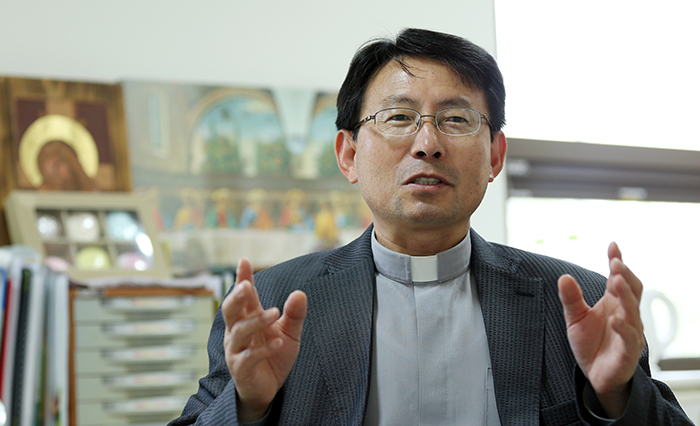
By Limb Jae-un
Korea.net Staff Writer
jun2@korea.kr

Yeosaul was a major transportation hub, where the small Sapgyeocheon and Muhancheon rivers met. The Sapgyocheon was so deep that ships were able to reach far inland and people took boats to Seoul from Yesan and Hongseong counties. The name Yeosaul is said to have originated from "Yeoseul," a creek with fast moving water. On a small hill at the Yeosaul Holy Place is a large stone signpost showing that this is the birthplace of Lee Jonchang. There is also a picturesque church on the opposite side.


The Yeosaul Holy Place in Yesan County, Chungcheongnam-do, is the birthplace of the 'Apostle of Naepo,' Lee Jonchang. Nowadays, there is a church on the site. (photos: Jeon Han)
Lee, who was an in-law of the families of both St. Andrew Kim Dae-geon and Thomas Choi Yang-eop, played a key role in spreading Catholicism in the area. Born to a rich farming family, when he grew up and became a young man, Lee went to Seoul with a yearning for knowledge. There, he met the great scholar Francesco Saverio Kwon Il-sin and became his pupil. In 1785, Lee was baptized and converted to Catholicism.
Lee returned to his hometown to spread the Gospel and convinced his family and relatives to join the faith, as he was responsible for spreading the teachings of Catholicism across the Chungcheong-do region. Soon, the village became a religious community with 300 followers. Later, Lee taught the Gospel to the farmers and to the lower classes in the Naepo area, now including the towns of Yesan, Asan, Dangjin, Haemi, Deoksan, Hongseong and Seosan. It was then that Naepo became a starting point for Catholicism in Korea.
The fifth Bishop of Joseon, Marie Nicolas Antoine Daveluy (1818-1866), wrote that most Catholics in the 1850s were descendants of those who Lee helped to join the faith. Eventually, Lee became an apostate, as he gave in to severe torture and beatings during the great persecution of 1791, but he deeply repented his apostasy and tried to continue teaching the Gospel. However, he was arrested again in 1795 and lived in prison until his death in Gongju in 1801.
Hongseong Country, Chungcheongnam-do, formerly known as Hongju, is also one of the places where Lee Jonchang taught Catholicism. According to records, there were 212 martyrs executed here, but if nameless martyrs are included, the number would grow to over 1,000.
Commoners and the lower classes of Naepo willingly embraced Catholicism as they were moved by its religious doctrine that stresses equality before God. Hwang Il-gwang, a member of the lower classes, was one of the people who were strongly impressed when he was treated equally, without discrimination, by the aristocrats. According to records, he said, "People treat me so gently, despite my status. There must be a heaven in this world and another life in the afterlife."
In Hongseong County today, there is a well-organized pilgrimage route, called the Naepo Culture Forest Way. The route leads to the Hongju Martyrdom Holy Grounds, including the burial grounds and a place where many martyrs were executed. In 2012, a Joseon prison was restored at the Hongju fortress. Many followers kept their faith while in prison, despite torture and executions. The pilgrimage also heads to the Wolgyecheon Stream. There are signs showing that there were executions and burial grounds near the stream. Many martyrs, including Hwang Il-gwang, were beheaded on these execution grounds.


(Top) The burial grounds at the Hongju Martyrdom Holy Ground in Hongseong County, Chungcheongnam-do. (Bottom) The rebuilt prison at the Hongju fortress, where many Catholics kept their faith, despite torture and executions. (photos: Jeon Han)
"Scholars who lost power during the reign of King Sukjong (r. 1674-1720) came down to the Naepo area, which was close to Seoul, and studied Western learning, which led to the growth of Catholicism in Naepo," said Father Youn In-gyu Laurentio, the current rector of the Yeosaul Holy Place. "This was an early Catholic community that continued to thrive until the great persecution of 1866. This is a historic place."
"The people of Naepo had hopes for a new era, which they aspired to realize in the afterlife, and thus eagerly accepted Catholicism," Youn said. "This is also because, as the Bible says, 'The time promised by God has come at last!' Martyrs were willing to give up their life, not only because they had aspirations for a new era, but also because they had a spiritual experience."

The rector of the Yeosaul Holy Place, Father Youn In-gyu Laurentio, says, 'Scholars who lost power during the reign of King Sukjong came to the Naepo area, which was close to Seoul, and studied Western learning, which was the beginning of Catholicism in Naepo.' (photo: Jeon Han)
By Limb Jae-un
Korea.net Staff Writer
jun2@korea.kr
